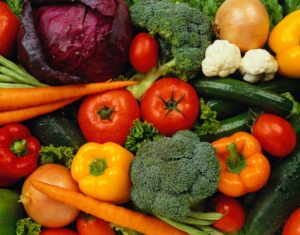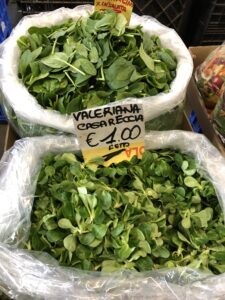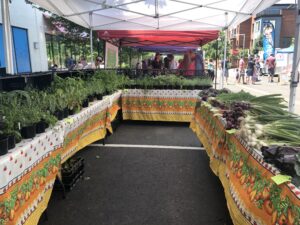Along with sunny weather and relaxing beach days, summer provides us with a wealth of produce. Whether you’re picking your own peaches, browsing through a farmers market, or grabbing tomatoes at the grocery store, there are many opportunities to take advantage of all the produce that summer has to offer. Delicious produce isn’t only available in the summer – you can get a variety of fruits and vegetables at any time of the year! In this blog post, we’ll explore the practice of seasonal eating and consider how it relates to conscious eating.
What is Seasonal Eating?
Although there are several definitions of seasonal eating, we will focus on the practice of purchasing and consuming fruits and vegetables harvested within the local climate (1). Those who participate in this practice opt for produce that’s naturally grown and harvested at any given time in the year. By doing so, they become aware of what produce is available to them and when. If they purchase foods from local vendors, they may even have a better understanding of the origins of the food they eat.
Seasonal eating encourages us to practice conscious eating habits through awareness of the foods we consume. We make more mindful decisions by understanding where our food comes from, how it is prepared, and its potential impact on us and our communities.
Benefits of Seasonal Eating
By using the seasons to guide our food choices, we can reap nutritional and economic benefits. Foods that are in season are typically harvested at their peak. Consequently, not only do they taste better but are rich in nutritional value. Since this produce is grown within our local climate, it also doesn’t need to travel far to reach our plates (2). This allows us to eat fresher, better tasting foods because the length of time between harvest and consumption is shortened. Seasonal eating not only enables us to find nourishment from food but also enhances how we experience eating it.
The advantages of seasonal eating extend beyond its potential health benefits. It may even help our pockets! If you take a look around your grocery store, you may notice that the seasonal produce is cheaper than, for example, those avocados shipped from Mexico. The availability of seasonal produce is abundant at harvest. You may find yourself saving a few dollars when choosing produce grown within or near your community (3).
The Impact of Seasonal Eating on our Communities
Seasonal food choices can also help us reduce our carbon footprint. Since seasonal produce can be found locally, it doesn’t need to travel far for us to consume it. As a result, less resources are used to transport food to its desired destination.
Additionally, through this practice, we tend to support our communities by purchasing foods from neighborhood vendors (4). This, in turn, benefits our local economy by funding and supporting local businesses. Moreover, through our support of local farmers, we can familiarize ourselves with how our food is sourced. We invest in the health of ourselves as well as our communities.
Tips on how to Eat Seasonally – Wherever you are!
What produce is seasonal for me?
The availability of produce can vary from region to region. In the Washington, D.C. area, we are able to access a variety of produce throughout the year. We may notice an abundance of:
- spinach and asparagus (spring)
- tomatoes and peaches (summer)
- sweet potatoes and pumpkins (fall)
- carrots and leeks (winter)
We’re able to access a variety of fruits and vegetables due to the significant changes between seasons. However, this may not be the case in other communities. If you are interested in learning more about what is grown in your area then the “Seasonal Produce Guide” can help you discover what is available near you (5).
Where can I find seasonal produce?
Whether you’re tending your own garden or purchasing produce from a vendor, there are many ways to gain access to seasonal produce.
Those who want to invest in local food production can join a Community Supported Agriculture (CSA). As a member of a CSA, individuals support a farm’s operations and in return receive seasonal produce on a regular basis (6, 7).
Through CSAs:
- individuals can support local farmers
- play an active role in how their food is sourced
- gain direct access to local seasonal produce.
If you want to support your local community, but don’t want to commit to a CSA, then shopping at a nearby farmers market and/or food co-op are other alternatives. At farmers markets or food co-ops, local vendors and farmers come together regularly to sell goods directly to consumers in their communities (8, 9, and 10). Since these vendors are local, farmers markets and food coops are able to offer their communities a wide variety of seasonal goods all year long.

Regardless of where you live, you can also find seasonal produce at your local grocery store. You may even see that some stores offer and highlight produce from local sources. By learning about what is seasonal in your community, you can choose the produce that doesn’t have to travel miles to reach your grocery store shelves.
How can I eat seasonally all-year-round?
While the availability of produce can change throughout the year, you may find yourself craving strawberries in the winter or sweet potatoes in the summer. Since seasonal produce is cheaper due to its increased supply, we can take advantage of its reduced prices to extend its longevity. We can freeze or can surplus produce to enjoy at any time of the year (11).
While seasonal eating may not fit everyone’s lifestyles, becoming more aware of what is available in your community can help you make more conscious food choices that may potentially benefit your health, communities, and your taste buds.
Sources
- Seasonality and dietary requirements: will eating seasonal food contribute to health and environmental sustainability?, https://www.cambridge.org/core/journals/proceedings-of-the-nutrition-society/article/seasonality-and-dietary-requirements-will-eating-seasonal-food-contribute-to-health-and-environmental-sustainability/08545F71A12EF0FE233E8D1DEFEF227A
- Locally grown, seasonal produce offers nutritional, environmental benefits, https://www.chicagotribune.com/sns-201410070000–tms–premhnstr–k-e20141008-20141008-story.html
- Seasons of Eating Infographic, https://www.heart.org/en/healthy-living/healthy-eating/add-color/seasons-of-eating-infographic
- Why Eat Seasonally?, https://www.seasonalfoodguide.org/why-eat-seasonally
- Produce Available in the US During Different Months of the Year, https://www.seasonalfoodguide.org/
- Community Supported Agriculture, https://www.nal.usda.gov/afsic/community-supported-agriculture#regional
- Local Food Directories: Community Supported Agriculture (CSA) Directory, https://www.ams.usda.gov/local-food-directories/csas
- Farmer Market Resources, https://farmersmarketcoalition.org/education/qanda/
- Local Food Directories: National Farmers Market Directory, https://www.ams.usda.gov/local-food-directories/farmersmarkets
- Food Co-ops, http://www.ecolife.com/health-food/eating-local/food-coops-csa.html
- 17 Strategies for Stashing Seasonal Produce in Your Freezer, https://www.thekitchn.com/the-seasonal-produce-i-put-in-my-freezer-love-your-freezer-216217





